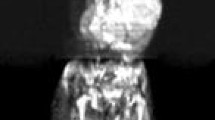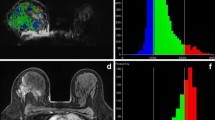Abstract
Background
Apparent diffusion coefficient (ADC) relates to tissue cellularity, and change in ADC during chemotherapy may be a promising tool for assessing oncological response.
Objective
To investigate the feasibility of measuring changes in ADC distribution in solid abdominal and pelvic paediatric tumours during chemotherapy, and to assess patterns of change.
Materials and methods
Consecutive children were included in a prospective observational study. ADC maps were calculated at presentation and following chemotherapy from a diffusion-sensitised sequence. ADC distribution in the whole tumour, excluding areas of low or absent gadolinium-enhancement, was investigated. Change during chemotherapy was assessed for each patient individually. Histopathological slices from the resected specimens were reviewed.
Results
There were seven children (nine tumours) included in the study. ADC in all except one deviated from a normal distribution. All tumours changed their ADC distribution during chemotherapy. Median ADC increased in all upper abdominal tumours, but more in tumours with histopathologically good or marked response to chemotherapy. Seven out of nine tumours attained a wider ADC distribution, the remaining two showed little chemotherapy response.
Conclusion
ADC distribution changes during chemotherapy in childhood abdominal tumours are measurable. Distinct patterns of shift can be observed and ADC change is therefore promising as a noninvasive biomarker for therapy response.



Similar content being viewed by others
References
Gow KW, Roberts IF, Jamieson DH et al (2000) Local staging of Wilms’ tumor–computerized tomography correlation with histological findings. J Pediatr Surg 35:677–679
Olsen ØE, Jeanes AC, Sebire NJ et al (2004) Changes in computed tomography features following preoperative chemotherapy for nephroblastoma: relation to histopathological classification. Eur Radiol 14:990–994
Humphries PD, Sebire NJ, Siegel MJ et al (2007) Tumors in pediatric patients at diffusion-weighted MR imaging: apparent diffusion coefficient and tumor cellularity. Radiology 245:848–854
Sury MR, Smith JH (2008) Deep sedation and minimal anesthesia. Paediatr Anaesth 18:18–24
Pickles MD, Gibbs P, Lowry M et al (2006) Diffusion changes precede size reduction in neoadjuvant treatment of breast cancer. Magn Reson Imaging 24:843–847
Uhl M, Saueressig U, Koehler G et al (2006) Evaluation of tumour necrosis during chemotherapy with diffusion-weighted MR imaging: preliminary results in osteosarcomas. Pediatr Radiol 36:1306–1311
Vujanic GM, Sandstedt B, Harms D et al (2002) Revised International Society of Paediatric Oncology (SIOP) working classification of renal tumors of childhood. Med Pediatr Oncol 38:79–82
Anderson J, Slater O, McHugh K et al (2002) Response without shrinkage in bilateral Wilms tumor: significance of rhabdomyomatous histology. J Pediatr Hematol Oncol 24:31–34
Author information
Authors and Affiliations
Corresponding author
Rights and permissions
About this article
Cite this article
McDonald, K., Sebire, N.J., Anderson, J. et al. Patterns of shift in ADC distributions in abdominal tumours during chemotherapy—feasibility study. Pediatr Radiol 41, 99–106 (2011). https://doi.org/10.1007/s00247-010-1741-4
Received:
Revised:
Accepted:
Published:
Issue Date:
DOI: https://doi.org/10.1007/s00247-010-1741-4




